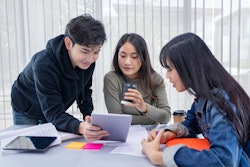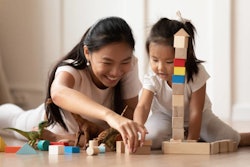Carving Out Their Own Niche
African-American cultural expression is one of the many influences fueling Asian-American artistry.
By Lydia Lum
Asian-American performers were few and far between when Dr. Oliver Wang was growing up in the 1970s and ’80s. Looking back, he says the lack of artists may have been the result of a lack of role models, since Asian immigrants didn’t begin to arrive in the United States in large numbers until after immigration laws eased in the mid-1960s.
Observers say Asian-Americans have tended to gravitate towards classical music and visual arts instead of verbal art forms like acting and singing. That’s not a surprise, given that many traditional Asian cultures are reproachful of speaking out, says Dr. Peter Kiang, director of Asian-American studies at the University of Massachusetts-Boston.
All this is changing fast though, and Black cultural expression is one of the many influences fueling Asian American artistry.
“African-American culture becomes a very obvious place to turn to because of its explicit engagements with race and the similar issues of marginalization in U.S. society,” says Wang, an assistant professor in sociology at California State University-Long Beach who teaches courses on popular culture and social issues.
Rapper apl.de.ap of the Grammy Award-winning hip-hop group Black Eyed Peas is one of the highest-profile Asian-American recording artists today. Born and raised in the Philippines, he has incorporated his native Tagalog dialect into some of the group’s song lyrics. Other rap artists popular among college students, Kiang says, include Cambodian-American Prach Ly and Vietnamese-Canadian Chuckie Akenz.
Wang, who has worked as a disc jockey and written extensively on pop music, estimates “a ten-fold explosion” among Asian-Americans in hip-hop and soul since the early 1990s. He attributes that to the easily accessible technology in the YouTube era that lets many individuals become a producer or singer virtually overnight.
And because nationalities like Cambodians, Vietnamese and Hmong have lived in large numbers next to and among Blacks, they have embraced the hip-hop influence faster than other demographic groups, Kiang says.
Here, Diverse takes a look at some notable Asian-American artists.
IBU
Since its 2001 formation in the Chicago area, the Asian-American rhythm-and-blues band IBU has captured the attention of college-age audiences and the recording industry. Some music insiders have called them the next Boyz II Men. Three years ago, the all-male trio won the R&B award at New York City’s International Music Fest.
Their name is short for “Inspired By You” because they say they feel motivated by the people they sing to. IBU is composed of Tommy Chanthasene, a Laotian-American, and Jonathan Shauf and Michael Musni, who are Filipino-American. All are younger than 30. IBU took root when Chanthasene and Shauf met at a karaoke bar and soon began collaborating. They later added Musni, who knew Shauf through break-dancing groups they had performed with.
IBU’s work ranges from close harmonies to hip-hop influenced urban contemporary sound. They have been known to perform a cappella or with an accompanying guitar, and their performances sometimes include break dancing or choreographed numbers. In addition to Boyz II Men, the members say they’re influenced mainly by Justin Timberlake, Brian McKnight, ’NSync and BBMak. They have performed with Jennifer Hudson of “Dreamgirls” fame, among other artists.
IBU’s latest CD, “Redefined,” features self-written ballads as well as up-tempo dance tracks. Their recent and upcoming concert schedule lists universities around the country as well as venues in urban areas, both coasts and in predominantly White pockets of the Midwest.
The band’s Web site has included cheers from fans that applaud them for carving a place for themselves in a genre heavily dominated by African-Americans.
Bao Phi ***image2:right**
we called each other Beaulieu, Saice,
Mustafa, Nguyen,
we talked about hip hop and minimum wage jobs
and the girls who broke our hearts
in languages that they call ebonics, pidgen, res
accented, or improper broken english
we ran in the confused streets of Phillips
from the police
from the crazies
from our own mothers
we ran
till our chests burned and our hearts
hungered for any place to call home
we ran but we didn’t call it running no
we called it hangin we called it doing something
we called it surviving
Excerpts from the poem “Calling,” by Bao Phi
A native of Vietnam, spoken word poet Bao Phi has drawn much material from growing up alongside Blacks and American Indians in one of Minneapolis’s poorest neighborhoods. Admirers have praised his performances, which often include outbursts and tears, as challenges to the audience to contemplate racism, community and taboo subjects.
Now 32, he has spent more than half of his life performing in shows and poetry slam competitions around the country.
He is one of the first Vietnamese-Americans to have appeared on HBO’s “Russell Simmons Presents Def Poetry.”
Phi’s father served in the South Vietnamese army during the Vietnam War, but escaped to the United States with his family shortly before the fall of Saigon in 1975. In America, Phi’s father often took him to the library in Minneapolis, eventually teaching him the route so he could walk there himself. There, he developed a love for drawing as well as reading and writing fiction.
In high school, Phi got involved with public speaking as well as theatre and art groups. He says his primary influences at that point in his life included the rise of hip-hop, the first Persian Gulf War and the Rodney King beating and subsequent riots.
Phi has performed at many universities around the country.
His poetry has been included in some high school textbooks and in course material of Asian-American studies classes nationally. He has published in journals such as the Michigan Quarterly Review, and anthologies such as Legacy to Liberation, which focuses on Asian-American revolutionaries. One of his poems was among 75 compiled in The Best American Poetry 2006.
Nobuko Miyamoto
In half a century, Nobuko Miyamoto’s career has gone from Broadway to Hollywood to community activism and on to socially conscious performance art. A pioneer among Asian-Americans, she has nurtured future leaders in the arts through her Los Angeles-based organization, Great Leap.
Trained as a dancer and singer, Miyamoto performed on Broadway as a teenager in the 1950s, appearing in musicals such as “Flower Drum Song.” She also earned roles in the Hollywood productions of “The King and I” and “West Side Story.” The 1986 film “Karate Kid II” featured choreography and a song from Miyamoto.
Things took a twist in the 1960s, when she was asked to work on a film about the Black Panthers. She and a crew interviewed activists and got a firsthand view of countless demonstrations. Miyamoto says that experience helped her recognize the similar ways discrimination had affected Black and Asian-American communities.
She says she became inspired to get involved with New York’s Asian-American community, which was working with Puerto Ricans and Dominicans to fix old, vacant buildings to provide housing for the poor.
During the Vietnam War, Miyamoto and two other musicians challenged the war effort by writing and performing songs aimed at convincing Asian-Americans not to fight against other Asians. Those recordings led to the seminal “Grain of Sand” album in 1973, one of the earliest compilations of Asian-American song.
During the ’70s, Miyamoto moved back to her hometown of Los Angeles and, in 1978, founded Great Leap. At first, it was mainly an Asian-American performance group. But she says the videotaped police beating of Black motorist Rodney King and the subsequent race riots in the early ’90s caused her to reconsider Great Leap’s future. As artistic director, she decided to make performances more multicultural to help audiences better understand the similarities between ethnic groups.
A number of different Great Leap shows have toured the country, including “A Slice of Rice, Frijoles and Greens,” which is performed by three or four artists. Using song, dance, mime, humor and puppetry, the artists illustrate their diverse backgrounds. The show draws 50,000 Los Angeles school district students every year. Another show included Japanese Buddhist monks, Jewish Rabbis and a Black Christian gospel choir. And Miyamoto’s one-woman show “A Grain of Sand,” which combines song, video and monologue, has toured colleges around the country as well.
Most of Great Leap’s productions are the result of teamwork between professional artists and community performers. Through these collaborations, Miyamoto has nurtured new leaders in community art, including an artist who founded one of the first Vietnamese-American theater groups.
Miyamoto has taught classes at the University of California,
Los Angeles. In 2003, she was among 17 people chosen for the Leadership for a Changing World Award by the Ford Foundation.
© Copyright 2005 by DiverseEducation.com


















